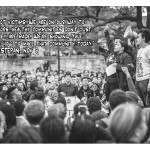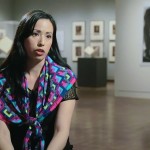Eshe Sherley
When it was announced that Janelle Monáe was going to headline this year’s Spring Fling, I may or may not have wailed for ten plus minutes in public. And I don’t have a bit of shame; because Monáe encompasses both the resistive and universal aspects of the long history of Black popular music through her intermingling of throwback, current, and futuristic sound profiles.
Monáe started her career in the Atlanta University Center, which is the home of three of historically Black colleges and universities: Spelman, Morehouse, and Clark Atlanta. Legend has it that at this time, she was a regular fixture on campus – performing and hanging out while living in a nearby boarding house. During this time, Monáe was also working on the unreleased album The Audition, which she self-distributed through her collective, the Wondaland Arts Society, around 2003.
The Audition, now a collectible item, introduces Monáe’s alter ego, Cindi Mayweather, a cyborg who, after falling in love with a human, is sentenced to being dissembled. Now on the run, Cindi emerges as a messianic figure as her escape turns into a movement to end the oppression of cyborgs everywhere. However, even though the beginnings of the funky, synthy, hybrid sounds, as well as the thematic elements that characterize Monáe’s later work are emerging, most of the album is dominated by a more traditional RnB sound, inflected with some funky elements. And so as much as The Audition portended the future, it also highlights Monáe’s roots in the wide-ranging pantheon of Black RnB, Pop, Soul and Funk classics.
Her next album, The Electric Lady, elaborates on these themes. The album, at a very full but entertaining 19 songs that clock in at a little over an hour, showcases the range of Monáe’s influences – from the classic 60s RnB of “It’s Code,” to “Ghetto Woman,” which sounds like it could have been written and composed by 70s Stevie Wonder, to a reggae, Lauryn Hill influenced detour Monáe takes in the song “What an Experience,” to the sexy, modern RnB of the fourth single off the album, and so far its most popular song – “Primetime,” featuring Miguel.
The album also showcases her politics. Janelle is all about the totality of the potential of Black art to touch people. She is just as likely to write the more traditional anthem to female self empowerment (see: Electric Lady) as she is to write songs that are literally for the revolution (see: Hell You Talmbout). She considers low-income women of color living in neighborhoods across the country serious song material – and not in the tradition of “I love my mama” hip hop songs that put mothers on pedestals rather than engage with them as people (see: Ghetto Woman). And as much as she is about writing music to lift up people who are struggling, she also writes about Black joy and sexuality, aka the turn up (See: Yoga and Givin Them What They Love).
And she manages to perform all this not just through her music, but also through every thing else that goes into her artistry. For any of you that haven’t seen this woman perform, don’t get too drunk on Spring Fling so that you can appreciate the gift the Spring Fling Committee has bestowed on us. She is high energy, expressive – a modern embodiment of a long tradition of masterful Black performance. She’s a little bit James Brown – and even though she’s from Missouri, a little bit Atlanta homegirl too. It’s a powerful and entertaining mix.
The sound Monáe developed between The Audition and The Electric Lady is both why her music can be described as “pop” or “accessible” while simultaneously producing some seriously powerful Black girl magic. Though the two aren’t mutually exclusive, often, Black girl magic goes unrecognized. Monáe has somehow figured out how to make hers legible without being as thoroughly pigeonholed as solely an RnB or Hip Hop artist as other successful Black entertainers who clearly have mass appeal. In other words, in a music industry landscape that pigeonholes someone like Rihanna, who is even more than a mainstream pop artist than Monáe, Monáe’s sound has managed to escape categorization and still be successful.
And it is this escape from categorization that is also at the heart of everything else that goes into Monáe as an artist beyond her sound. Her aesthetic. Her lyrics. Even her approach toward her public personae has a kind of hybridity that escapes definition. Monáe is intensely private. She wants you to focus on her music and her artistry, but that artistic product is also not running away from her actual (and alleged) identities – it is an unabashedly Black, woman-centric, class conscious, and one could argue, queer, product she is offering us, even as she, particularly on the topic of her sexuality, isn’t interested in allowing her life to be picked over by the media.
As ridiculous my quote was to the YDN when I said that Janelle Monáe was the best thing to happen to this campus in “a billion” years, I meant it. Monáe speaks to people of color, and particularly Black people, in a way that’s specific, important, and unprecedented on this campus. But she’s also just a badass. Or as she put it in an interview, “I think I’m cool. […] I am definitely in tune with the things that make me unique, and I use them as my super powers.”



